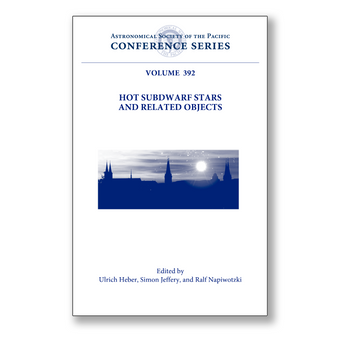Vol. 392 – Hot Subdwarf Stars and Related Objects
Your purchase of this volume includes a printed copy and electronic access. With your purchase of this title online, you will receive email instructions on how to access the e-Book version. If you wish to use our printable order form and mail or fax it to us, you will need to include your email address on this form in order to receive electronic access to the purchased volume(s).
Volume CS-392
Editor(s): Ulrich Heber, C. Simon Jeffery, and Ralf Napiwotzki
Print ISBN: 978-1-58381-654-7
e-Book ISBN: 978-1-58381-655-4
Published: 2008
These are the proceedings of the third international workshop on Hot Subdwarf Stars and Related Objects, held in the historic city of Bamberg, Germany, in July 2007.
Hot Subdwarfs represent several stages in the very late evolution of low-mass stars. B-type subdwarfs are helium-core burners at the extreme end of the horizontal branch, while O types represent a rich mixture of post-giant branch, post-horizontal branch and post-asymptotic giant branch stars. They are important for many fields of modern astrophysics. Hot subdwarf stars provide:
- The UV light of old unresolved populations, such as giant elliptical galaxies, which may be used to measure their ages
- laboratories to study plasma processes in high-gravity atmospheres, including radiatively-driven atomic diffusion and its consequences for the chemical composition of the star's outer layers.
- laboratories to study close binary evolution. Many have invisible companions, mostly white-dwarf mergers, while one has a planet, and others may have neutron-star or black-hole companions
- laboratories for asteroseismology. Pulsations check the evolution models by giving direct measurements of mass and radius, and the potential to explore other internal properties.
New instruments and theoretical models, as well as a vibrant young research community, are forcin rapid progress in all of these areas. These proceedings provide and informative snapshot of current research. They also include a small number of papers which have been extended to include an introduction for non-specialists. These papers offer a valuable resource useful to a wide audience including beginning graduate students and experienced reviewers for several years to come.
For more information about this publication and other ASP Conference Series Proceedings, click here (a new browser window will open).


